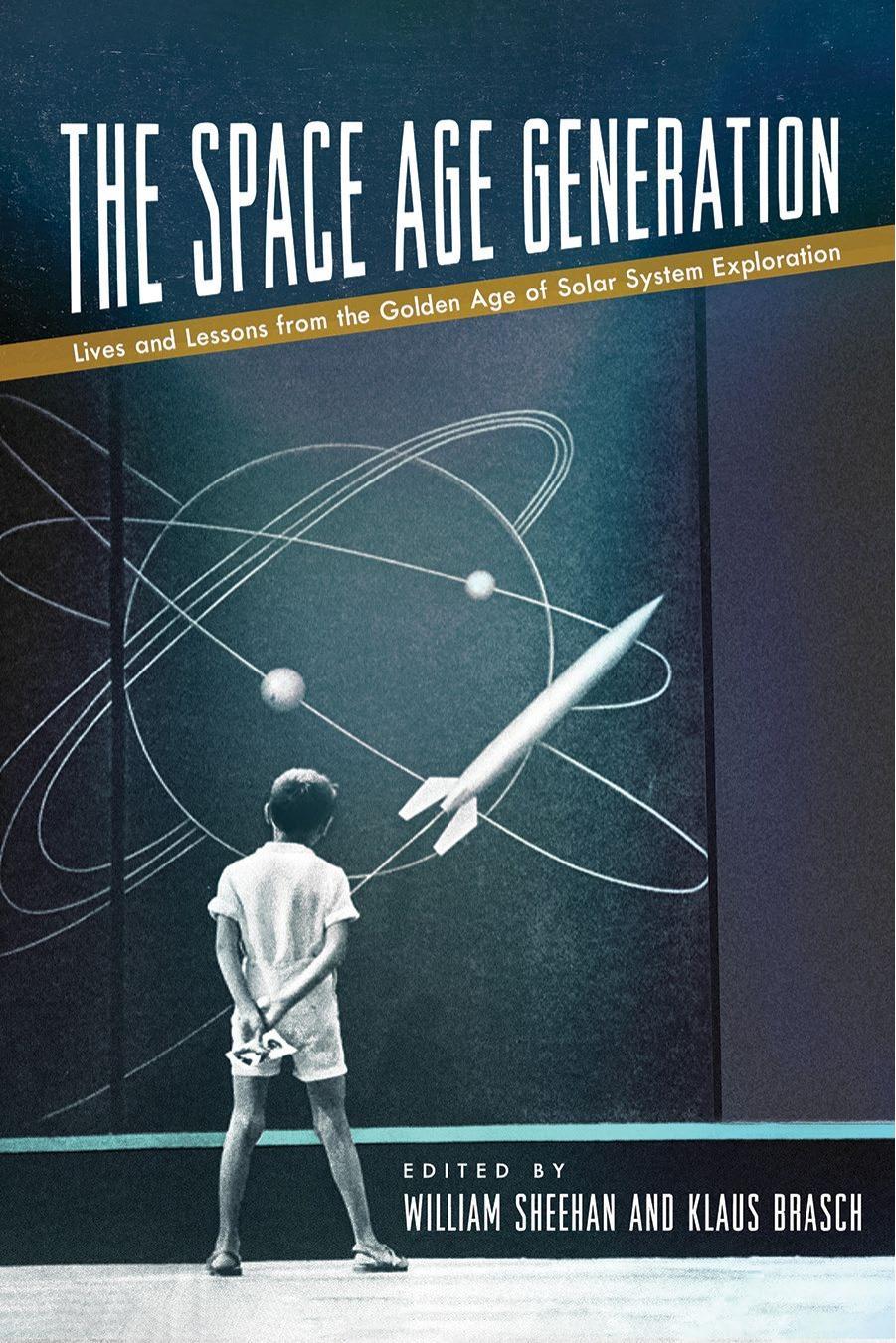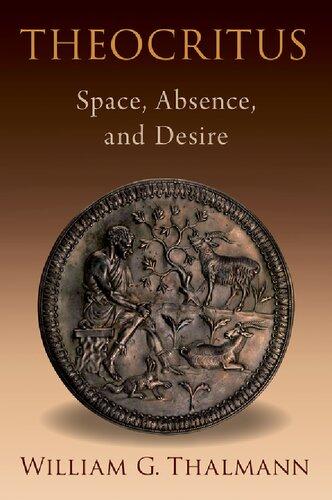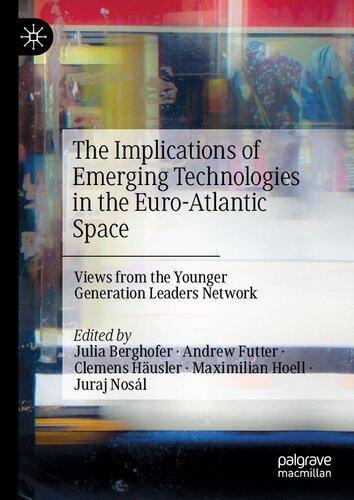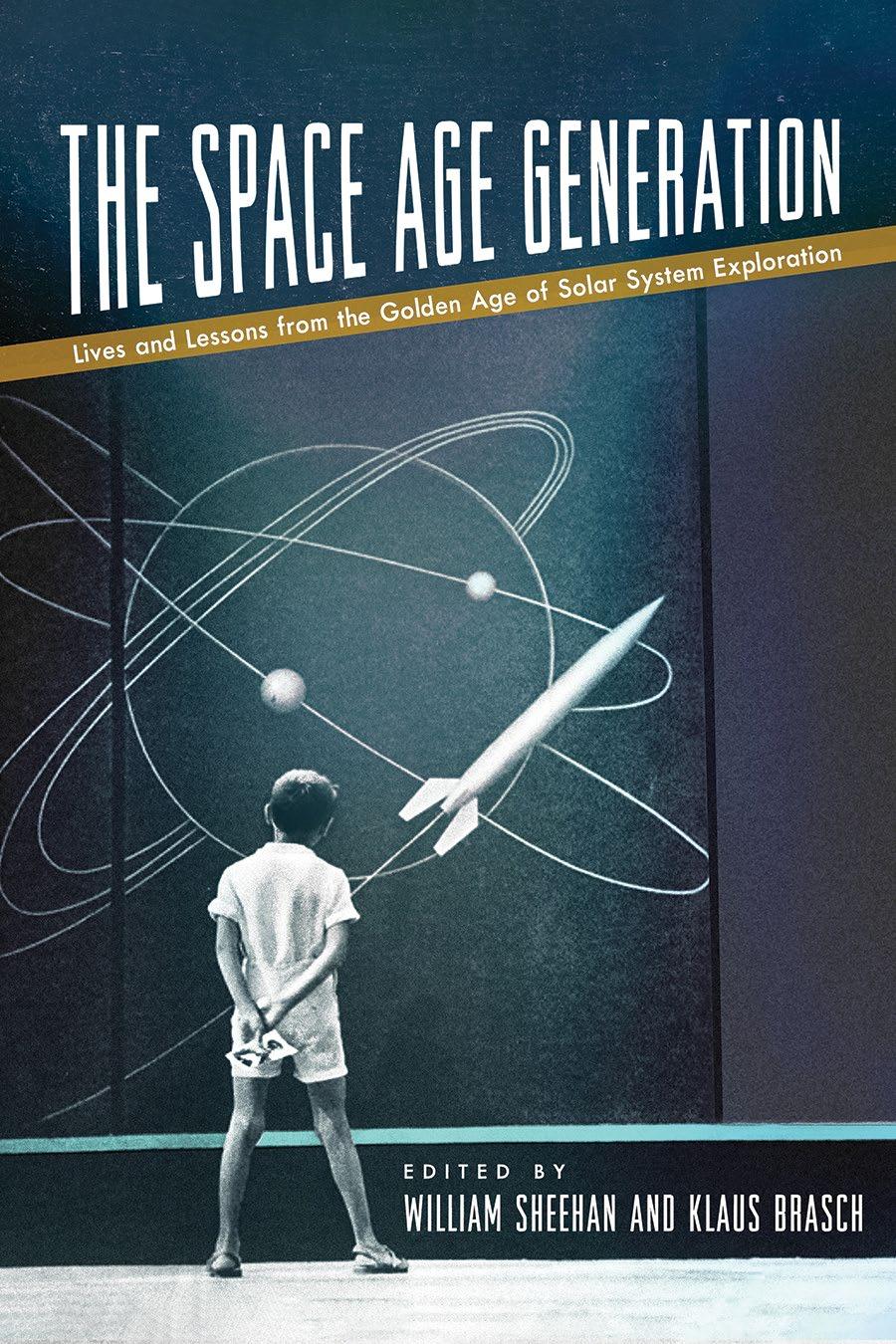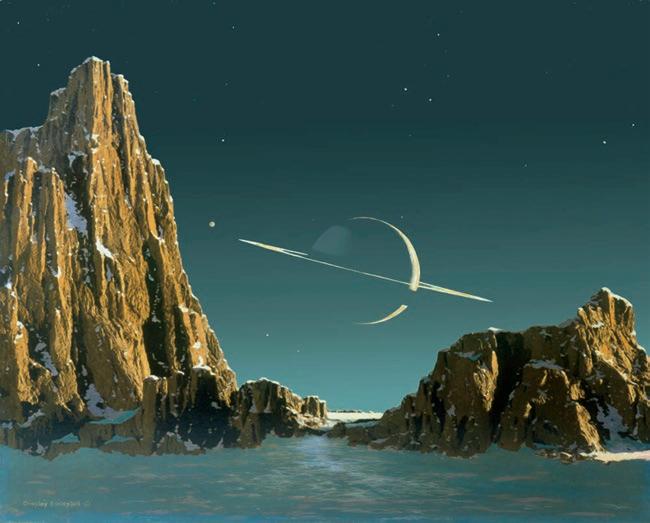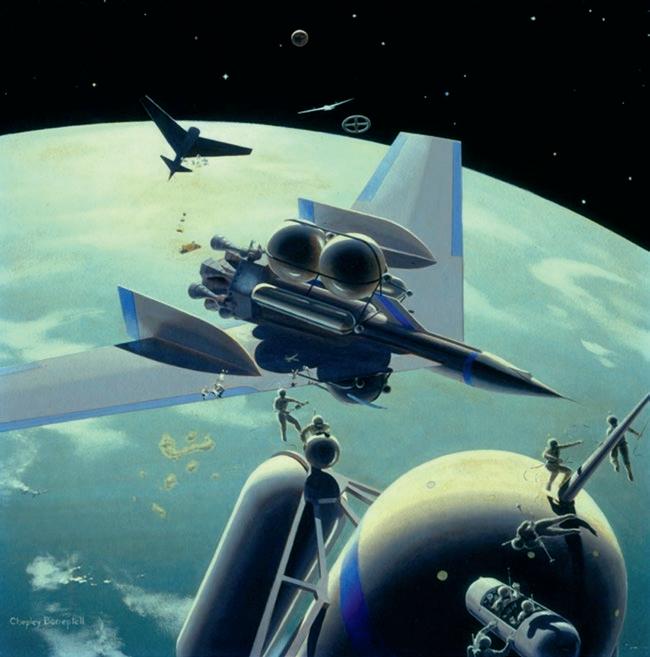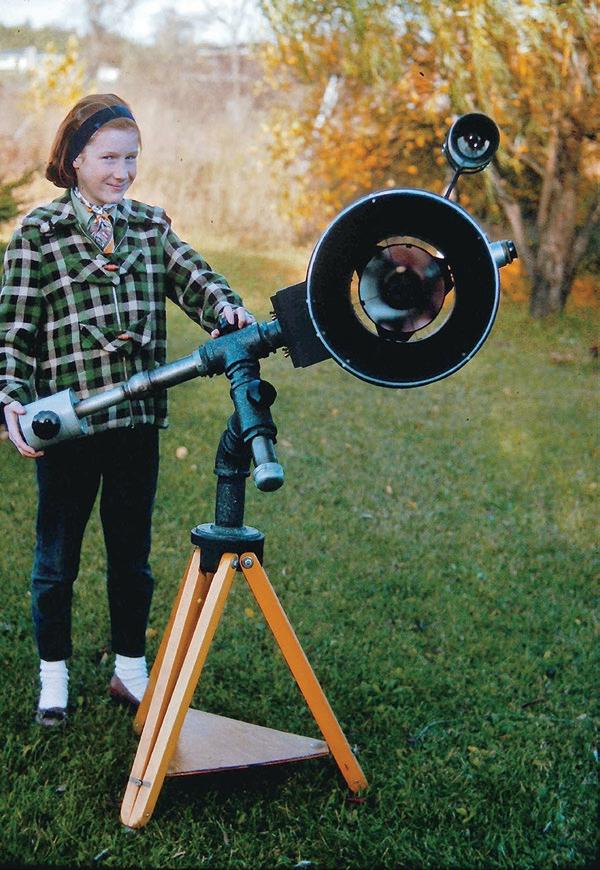THE SPACE AGE GENERATION
EDITED BY William Sheehan and Klaus Brasch
The University of Arizona Press www.uapress .arizona .edu
We respectfully acknowledge the University of Arizona is on the land and territories of Indigenous peoples. Today, Arizona is home to twenty-two federally recognized tribes, with Tucson being home to the O’odham and the Yaqui. Committed to diversity and inclusion, the University strives to build sustainable relationships with sovereign Native Nations and Indigenous communities through education offerings, partnerships, and community service.
© 2024 by The Arizona Board of Regents
All rights reserved. Published 2024
ISBN-13: 978-0-8165-5104-0 (hardcover)
ISBN-13: 978-0-8165-5105-7 (ebook)
Cover design by Leigh McDonald
Cover photos: ( front) The vintage image used on the cover is characteristic of an era when young boys were largely the audience targeted for astronomy and space. Artist unknown. (back) Heidi Hammel fills the dewar holding a CCD camera that sits at the bottom of the tube at the Cassegrain focus of the 88-inch telescope at Mauna Kea, Hawai‘i. Photo by Dale P. Cruikshank.
Designed and typeset by Sara Thaxton in 10/14 Warnock Pro with Iva WF, Payson WF, and Helvetica Neue LT Std
Library of Congress Cataloging-in-Publication Data
Names: Sheehan, William, 1954– editor. | Brasch, Klaus, 1940– editor.
Title: The space age generation : lives and lessons from the golden age of solar system exploration / edited by William Sheehan and Klaus Brasch.
Description: Tucson : University of Arizona Press, 2024. | Includes bibliographical references and index.
Identifiers: LCCN 2023031896 (print) | LCCN 2023031897 (ebook) | ISBN 9780816551040 (hardcover) | ISBN 9780816551057 (ebook)
Subjects: LCSH: Planetary science—History—20th century. | Outer space—Exploration— History—20th century.
Classification: LCC QB501 .T44 2024 (print) | LCC QB501 (ebook) | DDC 523.4092/2— dc23/eng/20230927
LC record available at https://lccn.loc.gov/2023031896
LC ebook record available at https://lccn.loc.gov/2023031897
Printed in the United States of America
♾ This paper meets the requirements of ANSI/NISO Z39.48-1992 (Permanence of Paper).
Dedicated to future generations of solar system explorers
William Sheehan
1. En Route to the Planets
William K. Hartmann
2. Pathway to Pluto
Dale P. Cruikshank
3. On the Way to Mars
Baerbel Koesters Lucchitta
4. First Light: Personal Reflections on Exploring the Moon and Planets
Peter H. Schultz
5.
6.
7.
Clark R. Chapman
William Sheehan
Klaus Brasch
William Leatherbarrow
PREFACE
This book grew out of a November 2021 article, “A Golden Age for Amateur Astronomy,” that we published in Sky & Telescope on the eightieth anniversary of the magazine’s first publication. The result of a merger of unsuccessful magazines The Sky and The Telescope, the new offspring survived World War II and the first postwar years. Only in the fifties and sixties, however, did it really come into its own. Sky & Telescope was successful for many reasons, including the increase in discretionary income during the postwar economic boom, which those inclined— after spending on new cars or TVs or dishwashers and washing machines— could spend on good telescopes. Even more significant, however, was that those were the years in which the space age got under way— with the first high-altitude rocket tests, artificial satellites, and probes to the Moon and planets.
Though we didn’t fully realize it at the time, we now look back to that era (as suggested in the title of our article) as something of a golden era for amateur astronomy. We found out, through the rather unprecedented response to our article by its increasingly aging readership, that it was a golden age for many others who grew up in that era as well, of whom not a few went on from humble beginnings building their own telescopes and making their own observations (it was “useful work,” we were assured) to become leading professional scientists involved in establishing the modern multidisciplinary science of the solar system. Of course, nowadays, with the range of sophisticated images taken even by amateurs with skill, leisure, and means, using charge-couple d devices (CCDs), as well as the onslaught of data being sent back by spacecraft and readily accessible on the internet, the
activities that absorbed us “in the good old days” are likely to seem rather tame. We certainly didn’t know very much, and a single enthusiastic author, like England’s Patrick Moore, could cover the waterfront with a series of books that included nary an equation and aimed its pitch perfectly to the level of any intelligent twelve-year-old. That so little was known, however, meant that the whole solar system was a realm of mystery, and it was the mystery that bestowed a peculiar piquancy to the whole enterprise— an enterprise in which we engaged in sketching lunar craters on lunar limbs or capturing visually fine details, such as canals on the surface of Mars or wisps in the zones of Jupiter, contributing our widow’s mite to the grand edifice of science. Indeed, until the nineties, the human eye remained supreme as a detector of planetary detail, only at long last to be cast into the shade through digital technology.
Every generation has its nostalgia and tends to think of itself as special. But those of us who belonged to the generation growing up during the space age were fortunate to live through a unique era, in which the Moon and planets were studied for the first time by spacecraft at close range. Though our knowledge now continues to increase by leaps and bounds, humans will never be so innocent again as we were then, never perhaps believe, with as much naïveté, that we could solve our problems on Earth and step out boldly and confidently across space from world to world. Ours was in a way a virginal time. We can never experience the “first time” twice.
The response to our Sky & Telescope article, which included some of those who agreed to contribute essays to this volume, shows that our feelings were widely reciprocated. The University of Arizona Press was also enthusiastic about the project. Thus we came to record some of the memories of a period that is now rapidly fading away, and that will soon be lost and indecipherable as time— or Lethe— irresistibly moves forward and plows them under.
For future generations interested in the history of humanity’s explorations of the solar system, we hope that this book may be useful in conveying some sense of what it was like for us to have lived through all that, even as they busily set about creating their own memories.
William Sheehan Klaus Brasch
Flagstaff, Arizona, USA February 17, 2023
Introduction
WILLIAM SHEEHAN
The naïve idea that we knew a great deal about the solar system and that there would not be many surprises in store in future years was certainly one of the first casualties of the unmanned planetary program. It used to be that a planetary astronomer was entirely safe in the sense that he could make any speculation whatever about a planet or life thereon and could rarely be proved wrong. . . .
Clearly the best time to be alive is when you start out wondering and end up knowing. There is only one generation in the whole history of mankind in that position. Us.
Carl Sagan, “A Very Special Time”
A Golden Age
It’s not always clear that one has lived in a golden age until after the fact.
In retrospect, the period from the early fifties until the late eighties was a one-off, a golden age of planetary science. Those like us who lived through it were fortunate in belonging to the generation that was the first to explore the solar system and thereby experienced what can never be experienced again. In our childhood the planets were “distant and indistinct discs moving through the night sky, and . . . in old age, . . . places, diverse new worlds in the course of exploration.”1
In the fifties, though full of hope, we actually knew very little. Now we know a great deal but— perhaps— are not so full of hope. In the fifties, the far side of the Moon was terra incognita, and speculation as to what might be found there was rife. The surface of Venus, cloaked under perpetually overcast skies, might be steaming jungles like those on Earth during the
1. Carl Sagan, The Cosmic Connection (New York: Doubleday, 1973), 69.
Carboniferous period. Mercury was believed to rotate in the same period as it revolved around the Sun, and so it was more or less half-baked and half-frozen— except, perhaps, in the “twilit” zone, which alternately enjoyed day and night and where life might have gotten a foothold. Mars of course was more evocative than any of the others. Percival Lowell’s whims of intelligent beings and canals to pump water from the polar ice caps were still remembered, and though they were no longer viewed as likely, it seemed possible, even probable, that lower life forms, like lichens, might exist on the planet. Jupiter’s Great Red Spot was possibly a large solid body floating in the planet’s atmosphere like an egg in a solution of salt and water. Saturn’s main rings— A, B, and C were well defined, but the finer structure sometimes glimpsed through large telescopes in excellent seeing conditions was largely unknown, as were the forces controlling that structure. Uranus, Neptune, and Pluto were virtually inscrutable, as were the satellites of all the planets except Earth and the asteroids. The Kuiper Belt and Oort Cloud were mere theoretical speculations. Theories of the origin of the solar system and of the Earth-Moon system were primitive. Even the origin of lunar craters was hotly debated, as it had been for centuries, with keen adherents to both the meteoritic and the volcanic schools. Whether the solar system we knew was rare or commonplace in the galaxy was unclear, and we had no firm knowledge, one way or the other, of extra-solar planets. Also unknown was whether life might be rare or commonplace, though as a matter of mere statistics (with an estimated one hundred billion suns in the galaxy), it appeared exceedingly unlikely that ours was the only technologically sophisticated civilization. UFOs were all the rage, and at least a few professional astronomers believed that representatives of the planets of other stars (and perhaps even Venus or Mars) might have visited (or be visiting) our planet. The first SETI (search for extraterrestrial intelligence) programs got under way in 1960, dedicated to picking up extraterrestrial communications with radio telescopes, and though if successful, we could undoubtedly learn a great deal from civilizations more advanced than ours, the prospect of disclosing our whereabouts was not entirely without danger.
The fifties— and on into the sixties and beyond— was certainly a golden age for young people interested in science. There was unprecedented support for science education, and funding for scientific research, especially at the new space agency, NASA, shot upward. Blending astronomy, geology, physics, chemistry and biology, the new discipline of planetary science
emerged to interpret the enormous amounts of data spacecraft were returning from other worlds, and within planetary science, subspecialities became more and more complex and particularized. Before long, no one person could possibly comprehend the big picture.
It was a golden age, and yet, living through it, it did not always seem like one. The period that saw the culmination of some of our oldest dreams, in which we ventured beyond the Earth, “the cradle of humanity,” in Russian space visionary Konstantin Tsiolkovsky’s words, came hard on the heels of a singularly horrific period of human history, which included the hideous stalemate of trench warfare in World War I; Stalin’s collectivization of farming, resulting in the starvation of millions; the gulags; the Nanjing Massacre; Hitler’s war; the Holocaust; and atomic bombs dropped on Hiroshima and Nagasaki. Ironically, the drive for more deadly weapons of warfare (modified ballistic missiles) became the very means that would allow voyages to the Moon and planets. It was the best and the worst of times, no different from any other except possibly more extreme.
Though the space age had many antecedents, it is usually said to have begun with the launch of Sputnik (i.e., “satellite”) on October 4, 1957. Early achievements include the discovery of Van Allen radiation belts by the U.S. satellite Explorer 1 in 1958 and the three Soviet Lunas of 1959, which were, respectively, the first spacecraft to reach the vicinity of the Moon, the first human object to reach its surface, and the first spacecraft to photograph the hitherto unseen far side of the Moon. The sixties saw the first weather satellite (Tiros), communication satellites (e.g., Telstar 1), men and women in Earth orbit, more probes to the Moon as well as to Venus and Mars, and finally, in President John F. Kennedy’s words, “landing a man on the Moon and returning him safely to the Earth.”
The backdrop to all this was the Cold War, in which two quasi empires, the democratic and capitalist United States and the autocratic and communist Soviet Union, struggled for global dominance. Politically, space was vital not so much in itself than in the prestige it offered whoever achieved mastery of it first. Each launch was a chance to demonstrate the awesome power of rocket systems to deliver payloads into space, whether these were probes sent to explore the Moon and planets or nuclear warheads intended for nothing less than the destruction of the Earth. Regardless of these mixed motives, the result was to be a golden age of space exploration, in which humanity first extended its reach into the solar system.
6 ♦ William Sheehan
The authors of the present collection of essays are among those who lived during that remarkable era and witnessed, or directly contributed to, its achievements, and now in late middle or old age, they are eager to set down their memories before those fade and are lost to recall forever.
Out of the Cradle
The space age had its roots in the twilight years of World War II, with the development of the A-4 ballistic missile, later named the V-2. One of these was launched to an altitude of 100 kilometers above Earth (and hence reached outer space) at Peenemünde on the Baltic on June 20, 1944. Developed under Wernher von Braun, who as a young man became enamored with the idea of interplanetary travel as a member of the Verein für Raumschiffahrt (Society for Space) and launched small experimental rockets from a field in Berlin, these small ballistic missiles had by the end of the war evolved into the brutal Vergeltungswaffen 2 (V-2)— the Retribution Weapon 2— that terrorized cities in Britain, Belgium, the Netherlands, and France.
Following Germany’s surrender in May 1945 and Japan’s in August, the empires that had divided the world among themselves at the beginning of the twentieth century were broken or destroyed. The United States and Soviet Union remained as the only “superpowers” still standing. At the moment, the United States, relatively untouched behind its oceans and not having had to fight a war on its own territory, had the upper hand. Von Braun surrendered to the U.S. Army to evade capture by the Soviets and brought some 120 of his engineers with him. Helmut Gröttrup and Fritz Karl Preikschat went over to the Soviet side. In the end, the U.S. advantage proved decisive: as Soviet cosmonaut Alexei Leonov told American astronaut Bill Anders in explaining why the Americans had won the race to the Moon, “Your Nazis were better than our Nazis.”2
As the war ended, both superpowers found that they were at least a decade behind the Germans in rocketry. Joseph Stalin ordered the release of all their own rocket experts from Soviet prisons, including Sergei P. Korolev, who had been rounded up in one of the notorious purges and now took charge of the Soviet rocket program. The United States, having captured the cream of Nazi rocket scientists, had also seized enough V-2 hardware
2. William A. Anders to William Sheehan, pers. comm., July 2018.
to build some eighty of the missiles, which it began testing, assembling, and launching for high-altitude research at White Sands, New Mexico. Though both von Braun and Korolev knew that missile development for military purposes was the highest priority of their respective governments, personally they were far more interested in using them for space travel.
Their dream was, of course, as old as Jules Verne, H. G. Wells, Konstantin Tsiolkovsky, and Robert Goddard— not to mention Lucian of Samosata. Suddenly, space travel no longer seemed so farfetched. Indeed, for many youngsters growing up in that era, flights to the Moon and planets seemed just around the corner. The imminence of our destiny in space was underscored by realistic movies, some of which featured astonishing art by Chesley Bonestell and others. Bonestell’s first foray into space art had been a series of paintings of Saturn as seen from each of its then-known moons, published in Life magazine in 1944, including Saturn as Seen from Titan (figure I.1), “the painting that launched a thousand careers.”3 These and other paintings, mostly made for science fiction magazines, appeared in the book The Conquest of Space (New York, Viking, 1949).4 In addition, Bonestell created huge backdrop paintings of the lunar landscape for the 1950 movie Destination Moon. The movie seems rather tame by today’s standards but was much admired by famed science and science fiction writers Isaac Asimov and Arthur C. Clarke.5 It also proved formative for several contributors to the present book.
Von Braun was among the greatest influences on the generation of future space scientists. In addition to his engineering prowess, he was a public relations and marketing genius (and successful, with the help of NASA and the Defense Department, in hiding the extent of his Nazi involvement during the war, which only emerged after his death in 1977). Von Braun, Willy Ley, and several others wrote “Man Will Conquer Space Soon!,” a series of articles lavishly illustrated by Bonestell, Fred Freeman, and Rolf Kelp for the magazine Collier’s between 1952 and 1954, which introduced the concepts of winged ferry rockets, anticipating the later space shuttles; of a spinning wheel-shaped artificial-gravity space station in Earth orbit; of space telescopes tended to by astronauts; and of bases on the Moon (figure I.2). At the time, however, humanity’s ultimate adventure seemed to be a voyage to
3. Ron Miller and Frederick C. Durant III, The Art of Chesley Bonestell (London: Collins and Brown, 2001), 47.
4. Willy Ley, The Conquest of Space, illus. Chesley Bonestell (New York, Viking, 1949).
5. Isaac Asimov, In Memory Yet Green (New York: Avon, 1979), 601.
Mars, the planet on which the existence of some forms of life was considered probable.
The means of how to go about it had already been outlined by von Braun in a book called the Mars Project, written to relieve his boredom while he was interned at White Sands. Its ambition was breathtaking: it called for a flotilla of spaceships to be assembled near the Earth-orbiting space station, each able to carry seventy humans via a 260-day minimum-energ y Mars transfer orbit to the red planet. So comprehensive were von Braun’s plans that he even pondered the possible psychological problems that might be encountered on the long trip to Mars: “At the end of a few months, someone is likely to go berserk. . . . [If] somebody does crack, you can’t call off the expedition and return to Earth. You’ll have to take him with you.” He proposed censoring radio communication to prevent the crew from hearing dispiriting news from Earth.6 Needless to say, many adolescents at the time were simply
6. Quoted in David S. F. Portree, Humans to Mars: Fifty Years of Mission Planning, 1950–2000, SP-2001– 4521 (Washington, D.C.: NASA, 2001), 3.
FIGURE I.1 Chesley Bonestell, Saturn as Seen from Titan , 1944.
8 ♦ William Sheehan
stunned by the concept of visiting Mars. So vividly was the human destiny in space imagined that there seemed no doubt as to its fulfillment in the rather near future. Von Braun himself predicted that the first human Mars mission would take place in 1965. That such a date could be taken seriously shows that— despite the Cold War and other existential threats to the planet— futuristic scenarios were not then as uniformly dystopian as they have since become. In the wake of World War II and demonstration of the staggering destructive power of atomic weapons in Japan, it seemed that humans had learned their lesson, and that organizations like the United Nations and an international system of banking would help mitigate international conflicts. The mantra was “Never again,” and humans proposed to swear off all that conflict and— with confidence in the genius of the species and belief in the inevitability of progress— were eager to rush forward to a world of possibil-
FIGURE I.2 Chesley Bonestell, Assembling the Ships for the Mars Expedition , 1956.
ities in the larger universe beyond the Earth and to finally venture beyond Tsiolkovsky’s cradle of mankind.
Rivals
Meanwhile, in the real world of rocket development, the early fifties saw the U.S. Air Force, Army, and Navy all competing to launch an artificial satellite into Earth orbit during the upcoming International Geophysical Year (IGY), 1957– 58. By demonstrating the superiority of its rockets, the United States meant to curb decisively Russia’s military ambitions. Technologically, the Soviet Union was regarded as (and was) rather backward. Alarmed at the lack of strategic parity with the United States, the Soviets in 1954 began secretively developing an intercontinental ballistic missile (ICBM) that would be capable of delivering a three-megaton nuclear charge able to reach the United States.
Though believing itself to have no real competition, the United States was to some extent in disarray, with each of the three branches of U.S. military working on its own proposal. Though the air force later developed what became the Atlas rocket, it did not yet have anything suitable. Von Braun, with the U.S. Army, wanted to launch the first satellite on a modified Redstone ballistic missile (a direct descendant of the V-2), which became known as the Jupiter C. In retrospect this was the strongest contestant. The navy’s system, based on the civilian Viking and Aerobee rockets, not ballistic missiles, was deemed less likely to alarm the Soviets and was given the green light to proceed in July 1955 as Project Vanguard. Launch was targeted for September 1957 during the IGY (July 1, 1957– December 31, 1958), but because of many delays, it fell behind schedule. This created an opening for the Soviets, and they seized it.
The Soviets had successfully tested the world’s first intercontinental ballistic missile on August 21, 1957. This was the R-7, a two-stage rocket with a maximum payload of 5.4 tons (enough to carry their hefty hydrogen bomb from the Baikonur launch facility to the mainland United States). As something of an afterthought, they capped this achievement with another, when Korolev arranged to have Sputnik 1 placed on top of another R-7 and successfully launched it into orbit on October 4, 1957. Though carrying a simple payload, an 83.6-kilogram polished metal sphere with external radio antennas able to broadcast radio pulses (bleep-bleeps) easily picked up by ham
10 ♦ William Sheehan
radio operators, Sputnik shocked the Western world, which immediately scrambled to catch up.
Clearly, a new era had begun— one that could happen only once, in which humanity’s image of the solar system would develop from a crude sketch to the detailed picture that is still evolving to this day.
Amateur Astronomers Still Have a Role to Play
In direct response to Sputnik, the National Defense Education Act was passed by Congress and signed into law by President Dwight D. Eisenhower in September 1958. Its intent was to “ensure trained manpower of sufficient quality and quantity to meet the nation’s national defense needs” and to help train a new generation of math and science teachers, scientists, and engineers. In tandem with this was a growing demand for information about space travel and the various bodies of the solar system.
It is now almost impossible to imagine just how exciting it was for those of us bitten by the astronomy bug at the time, when so much of the solar system was still unknown compared to now and when the promise of adventure lay ahead rather than behind us. A key difference was in how information was disseminated. Prompt access to vast amounts of data via the internet— like the latest images from rovers on Mars or orbiters around Jupiter— would have seemed pure science fiction then. After all, television was still a novelty, and for many with a budding interest in astronomy, the main source of information remained the astronomy shelf at the local library, often through books that were years, even decades, out of date. It’s no exaggeration to say that two developments at the time that galvanized amateur astronomers and nurtured the careers of many who went on to become professional planetary scientists were the publication of Sky & Telescope magazine and the emergence of prolific astronomy author Patrick Moore.
Created through the merger of two money-losing journals, The Sky and The Telescope, the new magazine, Sky & Telescope, began publication under legendary founders Charles A. and Helen S. Federer at Harvard College Observatory in November 1941 (a month before Pearl Harbor). Even with the interruption of the war, the magazine was immediately successful. The goal was to create as large a community as possible of amateur astronomers in the United States and to put them in touch with one another. As editor-in-chief, Charles was a perfectionistic, hands-on, exacting taskmaster, who insisted
that his staff be well informed about astronomy and that they get things right, which they consistently did. The magazine thus set a high standard from the start.
This hands-on approach fit well with the do-it-yourself and hobby movements of previous decades, when many readers took up the challenge of grinding mirrors and building their own telescopes. In addition to encouragement for those who wished to do-it- themselves, Sky & Telescope also published advertisements for complete telescopes, including Edmund Scientific, Criterion Manufacturing Company, A. Jaegers, and Cave Optical. Such ads launched the dreams of a thousand would-be professional astronomers, including some of those included in this book (figure I.3).
Patrick Moore, a self-taught English amateur who had served as a navigator with the Royal Air Force during the war, came on the scene with tremendous enthusiasm in the early fifties as a leading member of the British Astronomical Association (BAA), the premier amateur organization devoted to systematic studies of the Moon and planets. A practical astronomer, though without academic training in astronomy or geology, Moore specialized in studies of the Moon well before the first spacecraft reached it, producing book after book, including Guide to the Moon (1953), Guide to the Planets (1955), Earth Satellites: The New Satellite Projects Explained (1955), The Planet Venus (1956), Guide to Mars (1956), and The Amateur Astronomer (1957). In 1957 he received a contract with the BBC for a run of six astronomy TV programs to be called The Sky at Night. (Television was still a great novelty, and though TV sets were very expensive, seven million homes in Britain already had one.) The timing of Moore’s first broadcast was impeccable. When the program first aired in April 1957, a lovely naked-eye comet, Arend-Roland, was gracing the northern sky, and in the autumn of that same year, he discussed the implications of the launch of Sputnik. He later recalled the excitement of those early days:
Remember, in those days the Space Age was very young— it started only in 1957, and there were still many people who classed interplanetary exploration with science fiction. This meant that the pure observers were very much to the fore. . . . We were, for example, energetically mapping the Moon and, if anyone wanted a detailed view of, say, the crater Clavius, he was apt to turn to a Lunar Section publication rather than to anything else— if only because even the best photographic lu-
An 8- inch Cave Astrola reflector being readied for a night’s work by an eager young amateur astronomer, Patrizia Brasch. Courtesy of Klaus Brasch.
FIGURE I.3
14 ♦ William Sheehan
nar maps being produced in America still showed less detail than could be revealed by a good telescope, and were very defective in the libration areas. It seems strange to look back at this attitude now, when we have the close-range vie ws from the various manned and unmanned space vehicles.7
Moore always emphasized that there was still useful work to be done by anyone with enthusiasm and a reasonably good telescope. This might involve mapping limb areas on the Moon (an effort that was perfected by Bill Hartmann only a few years later) or looking for transient lunar phenomena, monitoring the ashen light of Venus or timing central meridian transits of cloud features across the disk of Jupiter to monitor the planet’s zonal winds. Such projects were promoted in his books and by BAA observing sections, as well as by the Association of Lunar and Planetary Observers (ALPO), founded in 1947 by Walter Haas, then a number cruncher at White Sands missile range and a mathematics teacher at the University of New Mexico in Albuquerque.
These organizations helped inspire many amateur astronomers to acquire observational skills, and at least a few made important discoveries— such as the four-day rotation of the upper atmosphere of Venus (by Charles Boyer, by profession a magistrate in the French Congo) and the hurricane- like internal rotation of the Great Red Spot of Jupiter (discovered by Elmer J. Reese with only a 6-inch reflector).
Professionals Join in the Quest
Professionals increasingly began to dominate solar system studies, though amateurs still contributed. A preeminent role was played by Dutch-born astronomer Gerard P. Kuiper, who in 1955, while at the University of Chicago’s Yerkes Observatory, became extremely interested in the Moon and more generally in the rigorous application of astrophysical methods to the bodies of the solar system. Kuiper was already a respected professional and, among other important discoveries, had detected methane in the atmosphere of Titan in 1944. Nevertheless, he respected amateur work, and wrote in 1961:
7. Patrick Moore, “The Nineteen-Fifties: The Space Age,” in The British Astronomical Association: The Second Fifty Years, 15– 16, BAA Memoirs, vol. 42, part 2 (London: BAA, 1990).
The phenomenal growth of astrophysics and the exciting explorations of the Galaxy and the observable universe led to an almost complete abandonment of planetary studies. . . . Physical observations of planetary surfaces, particularly Mars, led to controversies and speculations that may have been appreciated by the public but hardly by the professionals. More and more this branch of planetary work, including the study of the Moon, became the topic par excellence of amateurs— who did remarkably well with it. The Memoirs of the British Astronomical Association became the chief record for the development of planetary surface markings. Astronomers with large telescopes were so occupied with the engaging problem of stars, nebulae, clusters, the Galaxy, and the universe that astronomy became almost entirely the science of the stars.8
Kuiper’s interest in the Moon had been largely stimulated by Ralph Baldwin’s book The Face of the Moon, published in 1949, which argued convincingly for a meteoritic impact theory of the origin of the Moon’s craters.9 Yet, not everyone agreed with Baldwin’s analysis— Patrick Moore, for one, continued to hold forth for a volcanic theory of the craters’ origin— and it was clear that a great deal was yet to be done. In retrospect, a crucial date was August 1955, when the International Astronomical Union (IAU) held its annual meeting in Dublin, Kuiper was determined to champion lunar research in general and his own views about the Moon in particular. There was no entirely satisfactory map of the Moon at the time. A Welsh amateur and civil servant had just finished work on the largest hand-drawn Moon map (300 inches) ever made, but unfortunately, H. P. Wilkins was a rather maladroit draftsman, and on the reduced scale at which the map was reproduced (in Wilkins and Moore’s The Moon, published in 1955), it is so cluttered with fine detail (much of it fictitious) as to be almost unintelligible. Kuiper realized the need for a good photographic lunar atlas; at the IAU meeting he sought to generate interest, and well aware that the greatest expertise in such matters at the time lay with members of the BAA Lunar Section, he succeeded in enticing Alan Lenham, Ewen A. Whitaker, and (later) D. W. G.
8. G. P. Kuiper and Barbara M. Middlehurst, eds., Planets and Satellites (Chicago: University of Chicago Press, 1961), vi.
9. Ralph B. Baldwin, The Face of the Moon (Chicago: University of Chicago Press, 1949). Introduction ♦ 15
Arthur to come to Yerkes to work with him on this and other projects. Whitaker (after clearing the usual bureaucratic and professional hurdles) arrived at Chicago’s O’Hare Airport “just as the headlines of the evening newspapers were blaring, ‘Sputnik I orbits the Earth.’”10
Whitaker and Arthur were assigned to select fourteen-by-se venteen-inch prints of the best lunar photographs available (most were taken at the McDonald Observatory in Texas, but others were from Yerkes and Pic du Midi Observatory in France). Soon running out of allocated space for this, Kuiper converted the east attic at Yerkes (known as the “battleship” because of its porthole-like windows) into a suite of sizable offices, though when even this did not provide enough room, numerous portable tables were set up in the cavernous basement of the dome. Amid all this, Kuiper— now ser ving his second stint as observatory director— was fighting for his professional life. His tenure was “brief and stormy.” According to Yerkes historian Donald E. Osterbrock:
Kuiper was a great scientist who found it very difficult to distinguish between his own interests and those of his department and of astronomy. He sincerely believed that the research he was doing was the most important there was. Why else would he be doing it? It followed that all the resources of the university should be devoted to it. Why waste time on less important projects? He was always surprised if his colleagues did not see eye to eye with him. . . . Nevertheless, he had become an outstanding planetary astrophysicist, who had reawakened the whole field of solar-system research and made it once more a growing, vital scientific area.11
By the end of 1959, it was becoming clear that “all was not well at Yerkes. Undercurrents of discontent were circulating among some of the nonlunaroriented personnel. The trouble undoubtedly arose from the generally strongarm tactics that Kuiper used in promoting and favoring the Lunar Project over the more traditional fields of stellar, galactic and extra-galactic astronomy.”12
10. Ewen A. Whitaker to William Sheehan, pers. comm., July 2015.
11. Donald E. Osterbrock, Yerkes Observatory 1892– 1950: The Birth, Near Death, and Resurrection of a Scientific Research Institution (Chicago: University of Chicago Press, 1997), 312.
12. Ewen A. Whitaker, The University of Arizona’s Lunar and Planetary Laboratory: Its Founding and Early Years (Tucson: University of Arizona, 1986), 8.
16 ♦ William Sheehan
The solution was Kuiper’s departure to the University of Arizona, which recruited him to set up, with the Institute of Atmospheric Physics, what would become the Lunar and Planetary Laboratory (LPL) in Tucson. In addition to Whitaker and Arthur (Lenham having meanwhile returned to England), Kuiper gathered around him a group of talented graduate students, including Dale Cruikshank and Bill Hartmann. Chuck Wood joined as an undergraduate research assistant two years later.
The individuals discussed thus far entered solar system studies mainly through astronomy. Others with different backgrounds, however, such as geology and chemistry, were also attracted to the field. The first application of stratigraphy to understanding geological units on the lunar surface, for instance, was the work of geologist Eugene Merle Shoemaker, who in 1959 published what was immediately hailed as the definitive study of the formation near Winslow, Arizona, earlier known as Coon Butte, which had been famously misidentified by noted U.S. Geological Survey (USGS) geologist Grove Karl Gilbert as a steam maar, implying volcanic origin. Shoemaker, fresh from studying craters formed by underground nuclear explosions at the Nevada test site, realized that the crater (now known as Meteor Crater) must have been formed from an enormous blast like those produced by nuclear bombs and thus had to have an extraterrestrial origin. Though doubters remained (they always do), Shoemaker effectively proved Baldwin’s thesis that lunar craters had been formed by similar impacts, and in a classic 1960 study of Copernicus, the ninety-seven-kilometer-wide “monarch of the Moon,” demonstrated that no volcanic process could ever have produced an explosion capable of throwing out millions of tons of material across two hundred kilometers and more, and that the loops and chains of satellitic craters circling Copernicus must be secondary impacts, caused by debris thrown out at much higher energies than the thick and rugged ejecta that had cascaded over the crater’s outer flank.
Shoemaker was instrumental in forming the astrogeology branch of the USGS at Menlo Park, California (later moved to Flagstaff, where it remains today). In 1962, he published the first geological map of the region around the crater Kepler, in which he attempted to analyze the precise stratigraphic sequence of lunar formations. He, Baldwin, Kuiper’s student Hartmann, and others posited the likely occurrence of impact craters on other bodies, as was subsequently borne out in spacecraft images of Mars, Mercury, the Galilean satellites, and others. Impacts were also shown to be key in the accretion
